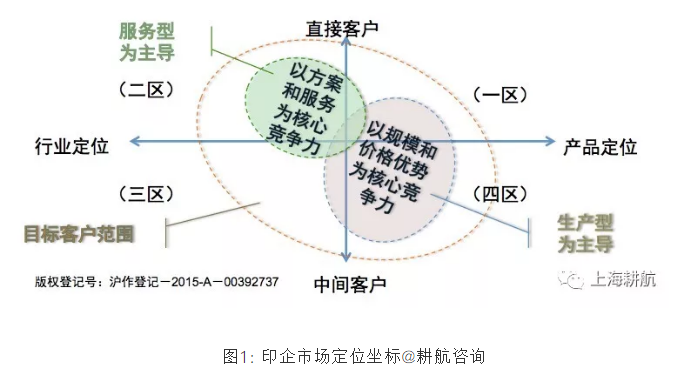
India enterprise consultation, is the ploughing!
What is the key to the integrated development of printing and packaging enterprises in the new era?
On June 20, fengyuan was invited to participate in the jingan district printing association's theme activities and did "innovation-driven, integrated development - into the new era of printing" theme exchange. Recently, this aspect of the subject has become a hot topic in the printing industry. Strategic, directional thinking has become a compulsory course for Indian managers. How to innovate? The direction of innovation needs to be determined first. Only when the direction is determined can we further understand what should be integrated and what should be avoided!
In the activities of the day, we have a strong interest in and resonance with the Indian enterprise market positioning model mentioned by feng yuan. This is the key to the integrated development of Indian enterprises in the new era. Please see the figure below (figure 1).

This picture was put forward by fengyuan in 2015 (it can be seen that the copyright registration time is "2015", which was also mentioned in the previous article). It can be said that the innovation and integration of Indian enterprises has been a concern in the industry, and the market positioning of enterprises is the key. Let's look at the main points in the picture first.
First of all, look at the vertical two ends, the upward is "direct customer", the main customers of fingerprint enterprises focus on the direct end customers, such as manufacturing industry, cosmetics, food industry, tourism, real estate, fast fashion and so on. Below are "intermediate clients", such as advertising agencies, trading clients, peers of Indian companies, and individuals who have run orders. The biggest difference between these two types of customers is that the intermediate customer is not a direct user of the printed product and will charge a certain fee or return to the final customer. Direct customers are completely different, they are most concerned about how to achieve their own information transmission efficiency and effect.
At both ends of the horizontal, the left end is the "industry positioning", fingerprinting enterprise target customers focus on one or a few industries, deeply embedded in the supply chain of target industry customers, to provide customers with comprehensive, value-added products and services. For example, tetra pak's deep involvement in the food industry, apart from the production and processing of the product itself, also provides services for the customer's supplier system and various links of the market channel. The right end is the "product positioning", fingerprinting enterprises to one or several categories of products as the focus, pay more attention to the product itself, do not pay too much attention to the industry attributes of customers, do not do in-depth service to the special requirements of the customer industry. Just like most printing enterprises in the market, the price of printed products, cost, quality, delivery time and other basic elements of the product itself pay more attention.
Further, the market positioning of Indian enterprises is divided into four areas by the horizontal axis and the vertical axis in the figure above, which are the four positioning directions we can see in the market. In fact, the current market positioning of many Indian enterprises is not conscious, strategic choice, but with the development of the market passive formation. When the market is good, you don't need to think too much, just make the customer's order well. Now the market environment has changed (the market environment will certainly change), Indian enterprises need to consider how to transform and upgrade, to consider how to break the situation, it is inevitable to think about the development direction of the enterprise, no matter how the enterprise considers, roughly the four directions in the figure above. If Indian companies want to make a difference in the integration of innovation, the first task should be to determine their own market positioning.
"One zone" positioning strategy is the direct customer orientation of product positioning. There are some successful packaging printing enterprises will naturally go to this position. As long as the service is good for a few super users, you can support a piece of heaven and earth, some Indian enterprises have successfully IPO. The biggest risk of this kind of market positioning lies in the excessive concentration of customers and the obvious bottleneck of the enterprise's development space.
"Two areas" positioning strategy is the industry positioning of direct customer direction. Just like tetra pak mentioned above, it has almost formed a monopoly position on packaging products in the food and beverage industry. Artron in domestic enterprises in the art market performance, also shows this trend. The positioning of "two regions" is also the business logic of "thick profit and more sales" advocated by European and American enterprises. Peak source calls this direction "sell value", also be to encourage the position that the enterprise inside course of study should choose.
"Three zones" positioning strategy is the industry positioning of the intermediate customer direction. From the peaksource's point of view, this area is the most dangerous. If an Indian company's main customers are several advertising agencies, and these advertising agencies focus on a few industries, the Indian company must have a hard time, unless you can control these agencies. The reason is that intermediate customers are not loyal, their understanding of printing than printing enterprises, so the price is their primary consideration. In addition, their own competition pressure is very big, business risk is also very big, this risk will naturally be transferred to Indian enterprises.
The positioning strategy of "four zones" is the intermediate customer orientation of product positioning. At present this area appears to be becoming the hot spot direction of the enterprise in the industry. Some print e-commerce platforms are striving to become the "super intermediate customers" of Indian enterprises, and some Indian enterprises are also actively making efforts in this direction. Peak source calls this direction "sell price", this direction is in domestic market or promising. For example, some companies specializing in plate printing, through continuous internal potential, constantly reduce the price, the formation of scale advantage. Also have the enterprise that makes special edition printing to also do well in 4 area fixed position respect, more representative if happy printing. In this respect, domestic domestic enterprises have a stronger competitiveness. So much so that when vistaprint pulled out of China two years ago, its executives said they couldn't win a price war there.
Through the above analysis, we further simplify the market positioning model of Indian enterprises as shown in figure 2.

In a word, Indian enterprises should first determine their market positioning. If such a big directional and strategic problem is not solved well, it will be difficult for enterprises to make a right choice on what to integrate and what to give up. Similarly, the direction of enterprise innovation must be consistent with the enterprise's market direction and development strategy. The most terrible thing is that an enterprise does not know and is not clear about its market positioning, or is in the "fuzzy positioning area" in figure 2. Such an enterprise must be in a passive operation state. One moment, it will encounter customers who are extremely sensitive to price, and the next moment, it will encounter customers who have many requirements and are picky. Often the big ones don't make money and the good ones are too complicated. And so on these are the enterprise's own positioning is not clear, there is no choice, less loss.
It is becoming increasingly clear that the time has come for Indian companies to make changes. The new era presents both new opportunities and new challenges. The biggest challenge for Indian companies is what path to take. Directional and strategic questions are always the most important. I believe that colleagues in the industry can choose the most reasonable direction, and stick to go, will certainly win challenges in the new era, and continue to find new opportunities.
India enterprise consultation, is the ploughing!

























